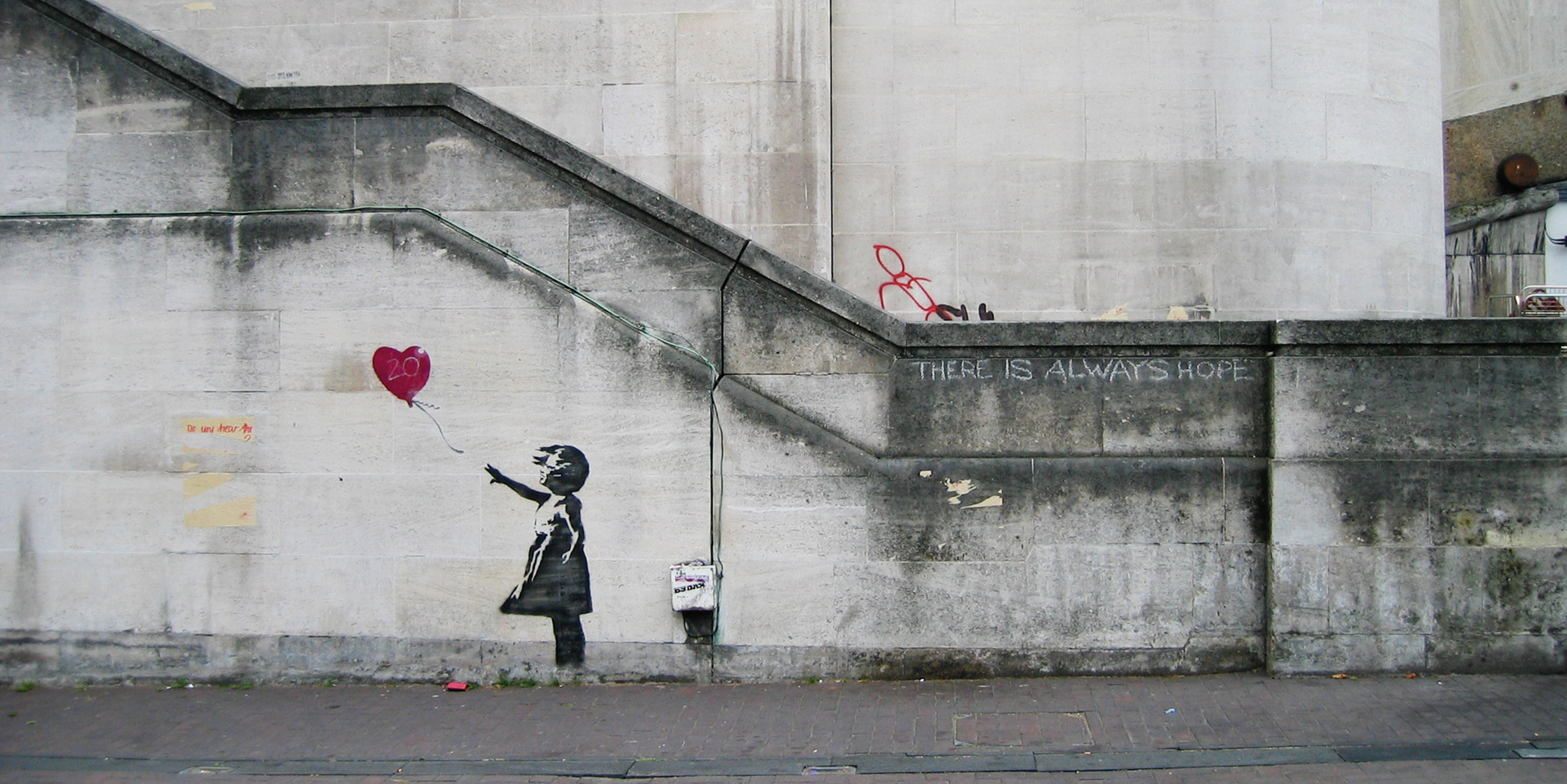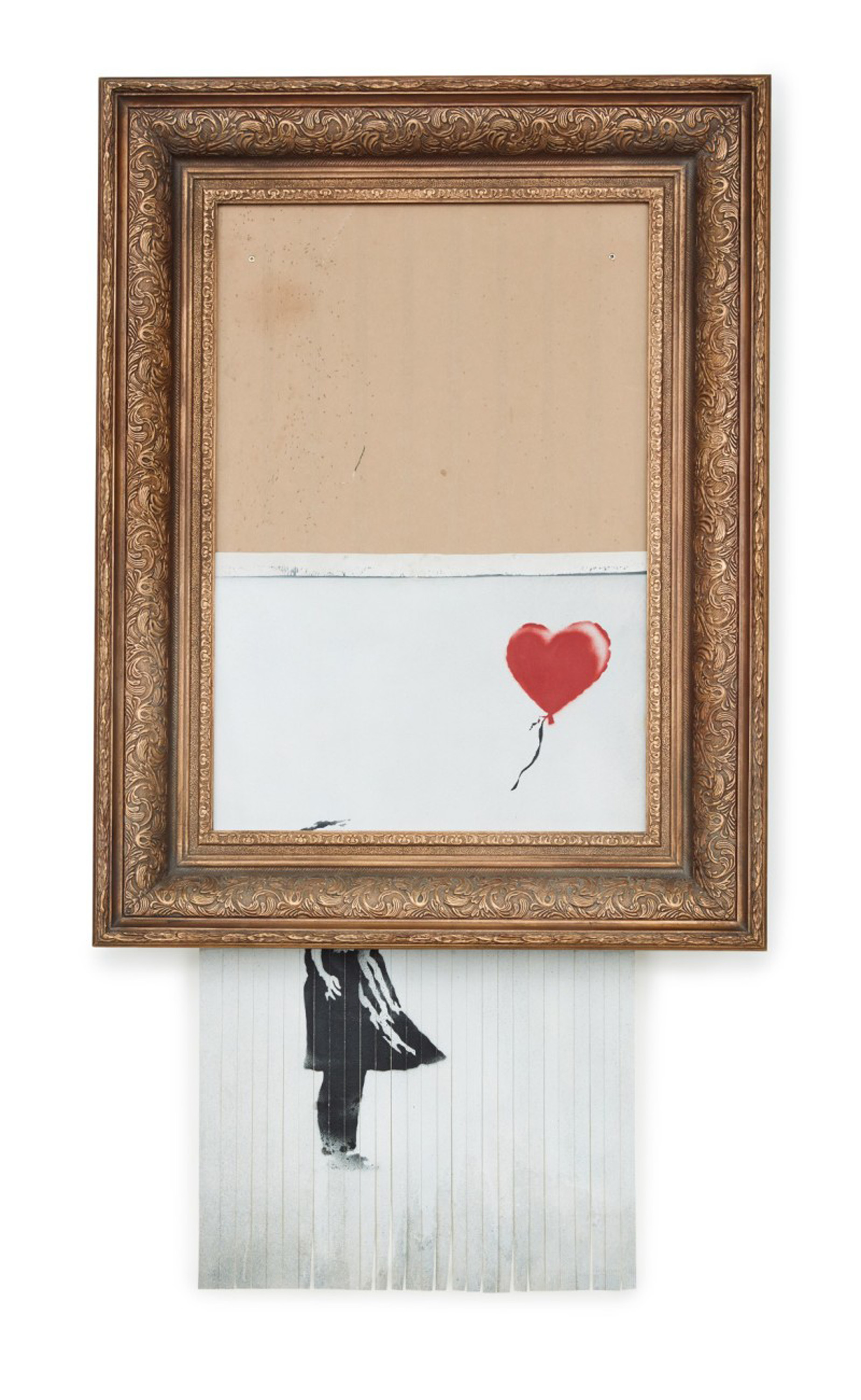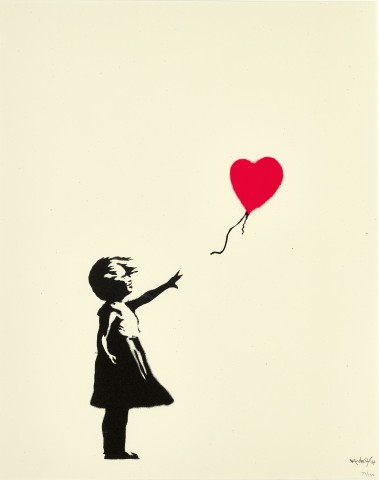GIRL WITH BALLOON, 2004
BANKSY
screenprint in colours
66.0 x 50.0 cm (sheet)
published by Pictures on Walls, London
signed dated and numbered lower right: BANKSY 04 / 71/150
Santa’s Ghetto, Pictures on Walls, London
Private collection, Sydney, acquired from the above in December 2004
This work is accompanied by a certificate of authenticity from Pest Control, London, issued in 2019, complete with one half of the corresponding, numbered, Di–Faced Tenner note.
Santa’s Ghetto, Soho Books, London, 1 – 24 December 2004
230105 cmyk FA.jpg

In 2010, Time magazine compiled a list of the 100 most influential people in the world, including the English street artist Banksy, who having always taken great care to protect his anonymity, appeared masked with a paper bag. Banksy’s messages, in contrast, are stenciled plainly on city walls, editioned in print and virally shared the world over, revealing boldly the unjust truths of contemporary society. Working from guerilla underground art scene of Bristol, Bansky’s humanist and provocative motifs were first painted directly, ‘bombed’, on the streets. Fulfilling a democratic and anti-elitist ethos, Banksy’s murals reached ordinary people on their commutes around the city, his distinctive style of visual metaphor quickly gaining broad popular support. As the cultural maverick Andy Warhol once astutely noted, ‘repetition adds up to reputation’1, and so the ubiquity of Banksy’s images has had an undeniable influence on contemporary culture, and none less than the bittersweet image of Girl with Balloon, his most iconic work.
Banksy’s figures are archetypes, simplified and easily readable. Broadly relatable in their melodramatic humanity, they become emblems around which to rally. With characteristic symbolic ambiguity, Banksy’s Girl with Balloon is an allegory for hope everlasting. Recalling the 1956 French short film Le Ballon Rouge, the blazing red of Banksy’s heart-shaped balloon provides a radiant beacon of brightness within the grisaille of the city. This motif of a young girl reaching out to its disappearing string carried on the wind first appeared in the London suburb Shoreditch in 2002, and shortly after it also appeared underneath Waterloo Bridge at South Bank. While the Waterloo example of this aerosol stencil mural was accompanied by a chalk epithet proclaiming, ‘there is always hope’, later printed editions of this image would rely solely on the visual power of the silhouette of the young girl, her dress billowing in the wind.
Banksy, like a latter-day Robin Hood, uses visual metaphors to anonymously highlight the corruption of innocence at the hands of capitalist and oppressive government regimes. Thwarting Banksy’s noble artistic intent of democratic access to art, many of Banksy’s original public artworks have been removed by overzealous council cleaners. His images instead survive printed on mobile supports, first stencilled directly on carboard protest placards and assorted reused surfaces, before being immortalized to the iterative medium of screen-print at the artist-run publishing cooperative Pictures on Walls. This example of Girl with Balloon is an early example from Pictures on Walls, printed in colour, hand-signed and numbered from an edition of 150.
230105 v.2.jpg

framed by the artist
mechanism remains in the frame
Banksy, in applying his stencil motifs to printed editions on wove paper, hand-signed, numbered and blind-stamped, accompanied with certificates from his own authentication committee, derides and dismantles the power structures of the fine art market from within. Harnessing an industrial means of mass reproduction, Banksy could circumvent commercial gallery structures by directly publishing his own printed oeuvre. Furthermore Banksy directly marketed these works to the public using tongue-in-cheek commercial initiatives, such as pop-up art happenings and an internet mail-order subscription service. This example of Girl with Balloon was acquired from one such ephemeral art happening, an annual festive group exhibition from Pictures on Walls selling limited edition prints cheaply from squatted premises in London’s SoHo. Called Santa’s Ghetto, this event was described in the press the year before as a ‘festive extravaganza of cheap art and related novelty goods from low-brow artists and trained vandals’.2
Silkscreen print reproduction has a long history with grassroots ‘do-it-yourself’ activism. Popularised during the student revolutions of the 1960s, printed posters were initially created for ephemeral purposes, reacting quickly to local events and carrying messages with time-sensitive and location-specific relevance. With images and text able to be uniformly copied cheaply and quickly, this means of print reproduction enabled young activists to ‘expose history’s blind spots and forgotten causes and sowed the seeds for today’s street artists. They remind us that social and political change often starts at street level’. 3 High-contrast, clearly delineated, icons create powerful and persuasive visual arguments easily read from a distance. Able to be reappropriated in the service of diverse social and political incentives, they are omnipresent in contemporary mass media and thus persist in the global public imagination. Girl with Balloon is a key example of Banksy’s innate understanding of the power of this mode of cultural communication.
Banksy stands on shoulders of giants, notably Andy Warhol, who was amongst the first to recognize the potential of the silkscreen to preserve the defining images of a generation. When widely distributed amongst a group of disparate individuals, these prints had the power to unite them in a common mind. While Warhol’s own experimentations with this medium blurred the boundaries separating painting, drawing and prints, he provided a framework to reinterpret this industrial medium into an aesthetic investment to be protected and exchanged, with value beyond the historical archive.
Since 2002, Girl with Balloon has become a beloved image with enduring appeal. Banksy has reused this motif in support of various social campaigns, by changing the design of the balloon, or dressing the girl in different costumes, such as in a mural on the West Bank in 2005, projected onto Paris and London landmarks in 2014 in support of the Syrian Refugee Crisis, and in 2017 on posters decrying Brexit. In 2018 Banksy memorably created a new artwork, titled Love is in the Bin, when a unique stencilled version of Girl with Balloon appeared to self-destruct seconds after being sold for a record price at auction in London. Love in the Bin, the new creation, partially shredded, subsequently selling for a new record of over £18 million in 2021.
1. Steiner, W., ‘Postmodern Portraits’, Art Journal, New York, Vol. 46, No. 3, Fall 1987, p. 1974
2. Cripps, C., ‘Graffiti with bells on’, The Independent, London, 1 December 2003
3. Rose, S., ‘Poster Workshop: The Art of Revolution’, The Guardian, London, 25 March 2011
LUCIE REEVES-SMITH
